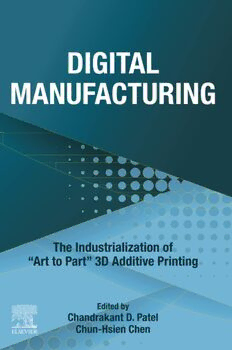
Digital Manufacturing: The Industrialization of "Art to Part" 3D Additive Printing PDF
Preview Digital Manufacturing: The Industrialization of "Art to Part" 3D Additive Printing
Digital Manufacturing The Industrialization of “Art to Part” 3D Additive Printing This pageintentionallyleftblank Digital Manufacturing The Industrialization of “Art to Part” 3D Additive Printing Edited by Chandrakant D. Patel HP Chief Engineer and Senior Fellow,HP Inc., PaloAlto, CA, UnitedStates Chun-Hsien Chen HP-NTU Digital Manufacturing Corporate Lab, Schoolof Mechanicaland AerospaceEngineering, Nanyang Technological University, Singapore Elsevier Radarweg29,POBox211,1000AEAmsterdam,Netherlands TheBoulevard,LangfordLane,Kidlington,OxfordOX51GB,UnitedKingdom 50HampshireStreet,5thFloor,Cambridge,MA02139,UnitedStates Copyright©2022ElsevierInc.Allrightsreserved. Nopartofthispublicationmaybereproducedortransmittedinanyformorbyanymeans, electronicormechanical,includingphotocopying,recording,oranyinformationstorageand retrievalsystem,withoutpermissioninwritingfromthepublisher.Detailsonhowtoseek permission,furtherinformationaboutthePublisher’spermissionspoliciesandour arrangementswithorganizationssuchastheCopyrightClearanceCenterandtheCopyright LicensingAgency,canbefoundatourwebsite:www.elsevier.com/permissions. Thisbookandtheindividualcontributionscontainedinitareprotectedundercopyrightbythe Publisher(otherthanasmaybenotedherein). MATLABsisatrademarkofTheMathWorks,Inc.andisusedwithpermission.TheMathWorks doesnotwarranttheaccuracyofthetextorexercisesinthisbook.Thisbook’suseordiscussion ofMATLABssoftwareorrelatedproductsdoesnotconstituteendorsementorsponsorshipby TheMathWorksofaparticularpedagogicalapproachorparticularuseoftheMATLABssoftware. Notices Knowledgeandbestpracticeinthisfieldareconstantlychanging.Asnewresearchand experiencebroadenourunderstanding,changesinresearchmethods,professionalpractices,or medicaltreatmentmaybecomenecessary. Practitionersandresearchersmustalwaysrelyontheirownexperienceandknowledgein evaluatingandusinganyinformation,methods,compounds,orexperimentsdescribedherein. Inusingsuchinformationormethodstheyshouldbemindfuloftheirownsafetyandthesafety ofothers,includingpartiesforwhomtheyhaveaprofessionalresponsibility. Tothefullestextentofthelaw,neitherthePublishernortheauthors,contributors,oreditors, assumeanyliabilityforanyinjuryand/ordamagetopersonsorpropertyasamatterof productsliability,negligenceorotherwise,orfromanyuseoroperationofanymethods, products,instructions,orideascontainedinthematerialherein. ISBN:978-0-323-95062-6 ForInformationonallElsevierpublications visitourwebsiteathttps://www.elsevier.com/books-and-journals Publisher:MatthewDeans AcquisitionsEditor:BrianGuerin EditorialProjectManager:RafaelGuilhermeTrombaco ProductionProjectManager:PrasannaKalyanaraman CoverDesigner:MilesHitchen TypesetbyMPSLimited,Chennai,India Contents Listofcontributors xiii Preface xv Acknowledgments xvii 1. A historical perspective on industrial production and outlook 1 ChorHiongTee Abbreviations 1 1.1 Introduction 2 1.2 Preindustrialization 3 1.2.1 Craftproduction 3 1.2.2 Agriculturalrevolution 3 1.3 FirstIndustrialRevolution 4 1.3.1 Mechanization 4 1.3.2 Laissez-fairecapitalism 4 1.3.3 Socialandenvironmentalimpact 5 1.4 SecondIndustrialRevolution 6 1.4.1 Divisionoflabor 6 1.4.2 Massproduction 7 1.4.3 Batchproduction 8 1.5 ThirdIndustrialRevolution 9 1.5.1 Automation 11 1.5.2 Numericalcontrol 12 1.5.3 Industrialrobots 14 1.5.4 Earlycomputers 15 1.5.5 Grouptechnology 18 1.5.6 Moderncomputers 23 1.5.7 Computersystemarchitecture 23 1.5.8 Computer-aidedapplications 26 1.5.9 Computer-integratedmanufacturing 33 1.5.10 Productdevelopmentprocess 36 1.5.11 Additivemanufacturing 41 1.5.12 Sustainabilityinmanufacturing 42 1.6 ForthIndustrialRevolution 46 1.6.1 Industrie4.0 47 1.6.2 Cyber-physicalsystem 49 1.6.3 Factoryofthefuture 50 v vi Contents 1.7 Summary 52 References 53 2. Digital product design and engineering analysis techniques 57 TianyuZhou,WeidanXiong,YukiObata,CarlosLangeand YongshengMa Abbreviations 57 2.1 Introduction 58 2.2 Productdesignprocess 58 2.3 3Ddigitalformcreation 59 2.3.1 3Ddigitalforms 61 2.3.2 Formmodeling 64 2.3.3 Casestudy 66 2.4 Intent-basedsystemicdesign 69 2.4.1 Functionalfeatureapproach 70 2.4.2 Feature-basedcomputer-aideddesignmodeling 73 2.4.3 Twotypicaldecision-makingtypes:retrievaland inspirational 80 2.5 Engineeringanalysis 82 2.5.1 Computationalfluiddynamicssimulation 83 2.5.2 Casestudy 86 2.6 Currentchallengesandfuturework 89 2.6.1 Currentchallenges 91 2.6.2 Expectedfuturework 92 2.7 Summary 94 References 94 3. Design methodologies for conventional and additive manufacturing 97 XueTingSong,Jo-YuKuoandChun-HsienChen Listofabbreviations 97 3.1 Introduction 97 3.1.1 DesignforAssembly 98 3.1.2 DesignforManufacturing 98 3.2 Designmethodologiesforconventionalmanufacturing 100 3.2.1 DesignforManufacturingandAssemblyguidelines 100 3.2.2 DesignforManufacturingandAssemblyprocedures 101 3.2.3 ApplicationsofDesignforManufacturingandAssembly 108 3.2.4 LimitationsofDesignforManufacturingandAssembly 110 3.3 Aparadigmshift 112 3.3.1 DesignforX 112 3.3.2 DesignforAdditiveManufacturing 113 3.3.3 Trendofhybridmanufacturingproduction 116 Contents vii 3.4 Designmethodologiesforadditivemanufacturing 117 3.4.1 NotableDesignforAdditiveManufacturingresearch works 117 3.4.2 DesignstagesofageneralDesignforAdditive Manufacturingframework 119 3.4.3 ChallengesofDesignforAdditiveManufacturing 136 3.5 Summary 140 References 140 4. Additive manufacturing for digital transformation 145 YuYingClarrisaChoong Listofabbreviation 145 4.1 Introductiontoadditivemanufacturing 146 4.1.1 Definitionsandterminologies 146 4.1.2 Overviewoftheadditivemanufacturingmarket 147 4.1.3 Industrydriversforadditivemanufacturingadoption 150 4.2 Additivemanufacturingprocesschain 152 4.2.1 Levelofadditivemanufacturingimplementation 152 4.2.2 Design,optimization,andsimulation 154 4.2.3 Materialselection 155 4.2.4 Manufacturing 155 4.2.5 Postprocessing 155 4.2.6 Processmonitoringandvalidation 157 4.3 Additivemanufacturingtechnologiesandprocesses 158 4.3.1 Vatphotopolymerization 158 4.3.2 Materialextrusion 164 4.3.3 Materialjetting 165 4.3.4 Sheetlamination 168 4.3.5 Powderbedfusion 170 4.3.6 Binderjetting 173 4.3.7 Directedenergydeposition 174 4.4 Casestudiesofadditivemanufacturingduringthe COVID-19pandemic 176 4.4.1 Providingrapidemergencyresponses 177 4.4.2 Masscustomizations 178 4.4.3 Agileoperationsandacceleratedproductions 178 4.4.4 Preservingsustainabilityandcontinuity 178 4.5 Summary 180 References 180 5. Simulation and optimization for additive manufacturing 183 HowWeiBenjaminTeo,KimQuyLe,KokHongGregoryChua andHejunDu Abbreviations 183 Symbols 183 viii Contents 5.1 Introduction 185 5.1.1 Macroscalemodeling 186 5.1.2 Mesoscalemodeling 187 5.1.3 Microscalemodeling 187 5.1.4 Parametersoptimization 188 5.1.5 Objectives 188 5.2 Areviewofmodelsemployinginadditivemanufacturing simulations 188 5.2.1 Powderinteraction 189 5.2.2 Heattransferandmeltpooldynamics 191 5.2.3 Lightsourcesimulation 195 5.2.4 Crystallization/microstructuresimulation 198 5.2.5 Summary 206 5.3 Topologyoptimization 207 5.3.1 Structuraloptimization 208 5.3.2 Typesoftopologyoptimizationmethodologies 210 5.3.3 Topologyoptimizationworkflowforadditive manufacturing 211 5.3.4 Availablecommercialsoftwarefortopology optimization 214 5.4 Summary 216 References 216 6. Polymer materials for additive manufacturing 221 JiaAn Listofabbreviation 221 6.1 Introduction 221 6.1.1 Molecularmaterial(cid:1)relatedclassifications 222 6.1.2 Molecularstructure(cid:1)relatedclassifications 223 6.1.3 Polymerclassificationforadditivemanufacturing 223 6.2 Thermosets 224 6.2.1 Curing 224 6.2.2 Curingcharacteristics 225 6.2.3 Dynamiccovalentbonds 229 6.3 Thermoplastics 229 6.3.1 Polymermelt 229 6.3.2 Rheologicalproperties 231 6.3.3 Thermalproperties 232 6.4 Printabilityin3Dprinting 234 6.4.1 Layering 234 6.4.2 Energyandmaterialbonding 236 6.5 Characteristicsof3Dprintedparts 240 6.5.1 Porosity 241 6.5.2 Anisotropy 241 6.5.3 Heterogeneity 242 Contents ix 6.6 Summary 243 6.7 Furtherrecommendation 243 References 243 7. Metal additive manufacturing 247 ChaoCaiandKunZhou Abbreviations 247 7.1 Introduction 248 7.2 Classificationofmetaladditivemanufacturingtechnology 249 7.2.1 Powderbedfusion 249 7.2.2 Directenergydeposition 252 7.2.3 Binderjetting 254 7.2.4 Sheetlamination 255 7.3 Preparationandcharacterizationtechniquesformetal additivemanufacturingfeedstock 258 7.3.1 Powderpreparationtechniques 258 7.3.2 Powdercharacterizationtechniques 260 7.4 Mechanicalpropertiesstandardtestingformetallic additivemanufacturingcomponents 263 7.4.1 Tension 263 7.4.2 Compression 263 7.4.3 Hardness 266 7.4.4 Fatigueperformance 268 7.5 Defectsinmetallicadditivemanufacturingcomponents 268 7.5.1 Defectcategories 270 7.5.2 Defectsdetectiontechniques 277 7.6 Postprocessing 281 7.6.1 Removalofadhesivepowders,supportstructures,and substrateplates 281 7.6.2 Heattreatment 283 7.6.3 Surfacefinishing 283 7.7 Applications 284 7.7.1 Aerospace 285 7.7.2 Automotiveindustry 288 7.7.3 Healthcare 290 7.8 Conclusionandperspectives 293 References 294 8. The emerging frontiers in materials for functional three-dimensional printing 299 JiaMinLee,SweeLeongSing,GuoDongGoh, GuoLiangGoh,WeiLongNgandWaiYeeYeong Listofabbreviations 299 8.1 Introduction 300 8.2 Compositesmaterialsforaerospaceindustry 302
